Built in 1929, the Robinson-Brown Building is located at 143 East Laurel Street. It is a two-story, brick building recently renovated under a grant as part of the Revive! program. The upper facade was previously covered by aluminum, and small ceramic tile covered the brick surrounding display windows. All this material has been removed. There are glass display windows on ground floor. The current building replaced a frame building that can be see in many early photos of this side of the square that was constructed by the same Judge Milton Perry Brown who was responsible for the Brown Building. This building has just been renovated by the Revive Scottsboro groups and is currently unoccupied.

Deeds, builders, and early tenants
This building was constructed in 1878 by William Delaney Parks Jr. (1852-1908). In the 1870 census, W.D. Jr. is 18 and living at home with his parents and siblings. His father is a farmer. W. D. Jr. went to Texas and met his wife Ada Rebecca Webb. They lived through 1874 where their first child was born. He then returned to Alabama where his next two children were born. In the 1880 census, W. D. Jr. and Addie are back living in Leon County, TX with their three children. While in Alabama he apparently had a connected shop and residence in what is now the Garland Building. A later ad indicates that the Parks family sold farm implements.
DEED BOOK 10, PAGES 29-30, dated October 20, 1879, Consideration: $2500.00, William D. and Addie Parks to Sallie M. Parks ONE TWO STORY BRICK STORE HOUSE SITUATED ON THE NORTH SIDE OF THE PUBLIC SQUARE in the plat of said town KNOWN AS LOT NO. 6 and also the dwelling house lot which lies north and is part of the said brick store house lot and includes the northern part of the Lot No. 7 known as the Abner Rosson shop and residence (shop and residence faced Willow Street). The BRICK STORE HOUSE being conveyed being occupied at present by the said William D. Parks and the second story thereof by Robinson and Brown, attorneys, and the said residence lot being occupied at present by John W. Hill.
In 1879, John W. Hill who lived in this house and was a 32-year-old house carpenter with a wife and three small children. Upstairs in this building is the office of Robinson and Brown, attorneys. In the 1870 census, W.D. Parks is 18 and living at home with his parents and siblings. His father is a farmer. W. D. Jr. met his wife in TX Ada Rebecca Webb in Texas and lived there through 1874 where their first child was born. Their next two children were born in Alabama. By the 1880 census, W. D. Jr. and his first wife Ada Rebecca Webb were living in Leon County, TX with their three children. While in Alabama he apparently had a connected shop and residence.
THIS WOULD HAVE BEEN BUILDING WHERE W. D. PARKS ADVERTISED AGRICULTURAL EQUIPMENT FOR SALE. In 1929 it became the site of the brick Robins and Brown Building. Here is the frame building that occupied this site before the 1929 brick building, the site of W. D. Parks Hardware.
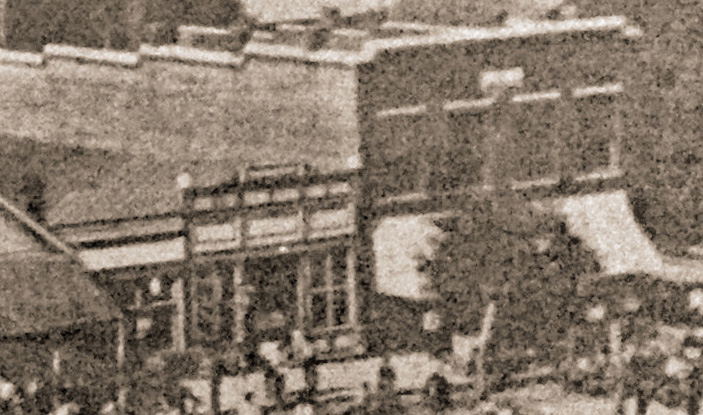
Deeds, builders, and early owners
The earlier building was constructed by Judge Milton Perry Brown for his daughter Evie Randall Brown Robinson and her husband William James Robinson to operate a grocery and funeral home business. Here is a photo of Evie and W. J. from their granddaughter. Here also is an ad from the 1902 Scottsboro Citizen about the funeral home part of this business. W. J. died in 1902, only 42 years old, and it is clear that Evie, her daughter Mayme, and her father M. P. Brown are trying to keep the business going and collect debts owned to them.
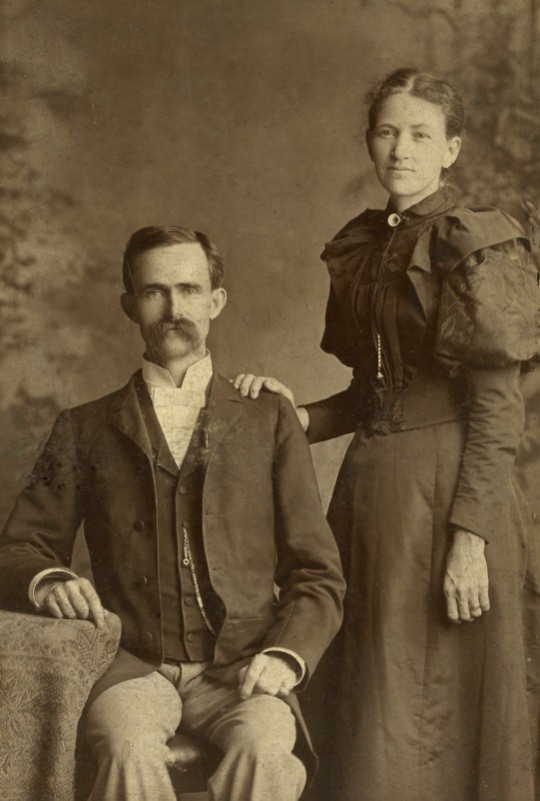
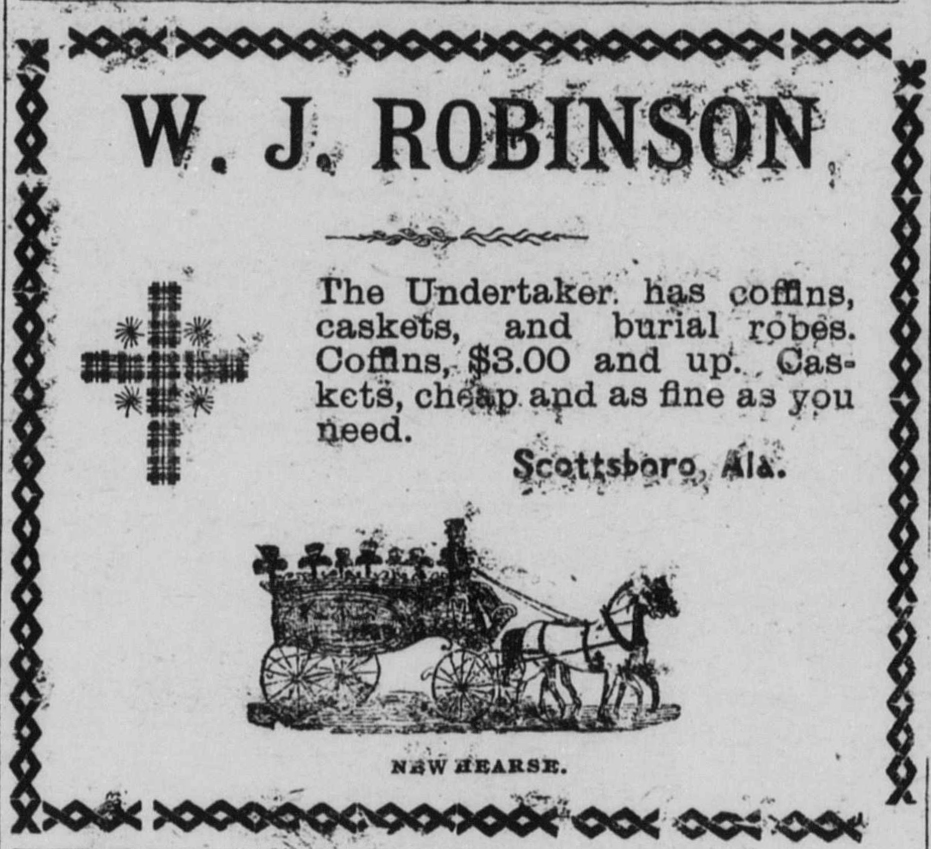
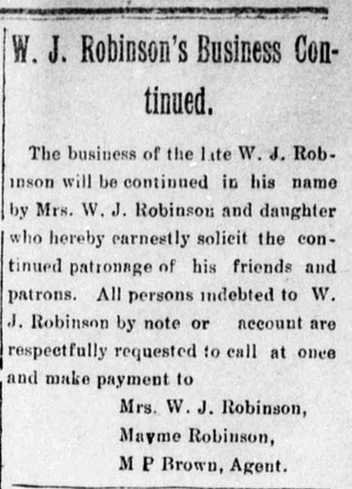
Ann Chambless searched for the deeds and made the following observations: “ Since Evie Robinson was the daughter of Milton Perry Brown, it is no wonder that William J. Robinson built his store (on Lot No. 2) next to his father-on-law's building that was on Lot No. 1. I do not have a deed record for original sale of these two lots. I used 1870 newspaper announcements to date the Brown building and its owner. Makes me wonder if M. P. Brown originally bought both Lot No. 1 and Lot No. 2 and helped his son-in-law and daughter build on Lot. No. 2.” She speculates that that is why she and Judy Proctor assigned the name “Robinson-Brown” to this building. Here is a photo showing the earlier building, the gabled, frame building on the site of the Robinson-Brown Building.
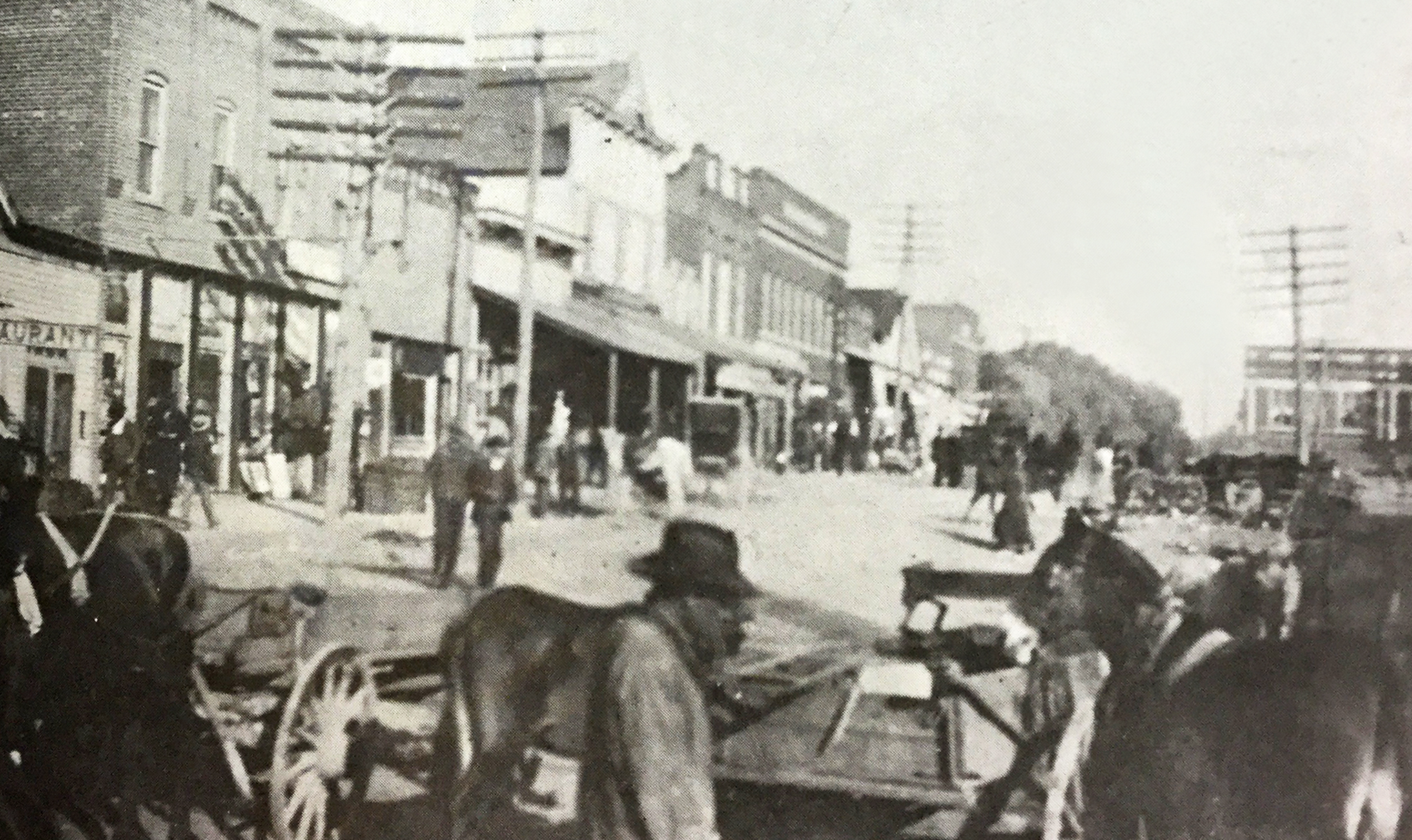
The Robinson family kept this property until the daughters were grown. Then the property was auctioned so that it could be divided among the descendants.
Deed Book 77, pages 377-378, B. F. Shook, Register of Circuit Court in Equity, under decree of Circuit Court in the cause of Margaret Robinson, et als -vs- Hattie Dell Shelton sold at public auction LOT NO. 2 known as W. J. ROBINSON PROPERTY. The two women in this suit are two of the legal heirs of W. J. Robinson. These heirs were were Hattie Dell Robinson Shelton, Margaret Robinson, Maymie Robinson Payne, Maud Robinson Lunsford, and Mathilde Robinson Campbell.
1939: group in front of the Quality Store
Stanley Jones, Coach Mickey O’Brien, and Claude Baker Jones in front of Hodges Drugs Store, with the Quality Store sign in the background.
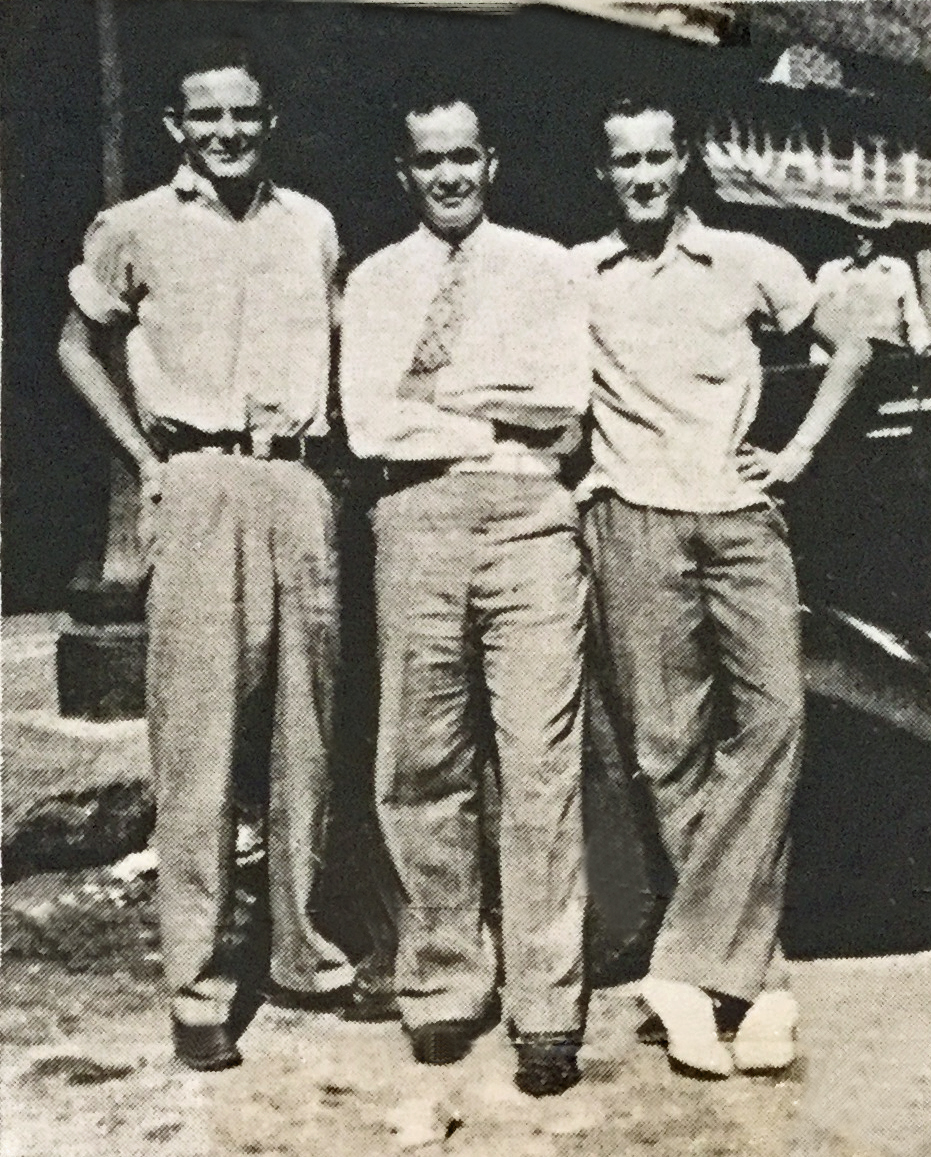
1940s-1970: The Quality Store
This building has been home to many area businesses. Immediately after the present building it was built, it was home to the Quality Store. In the 1956 and 1961 phone books, the Quality Store was at this location. By the printing of the 1966 phone book, the Quality Store had changed hands and was known as the Radliff Quality Store. A postcard photo from the 1940s shows The Quality Store as part of the north side of the square.
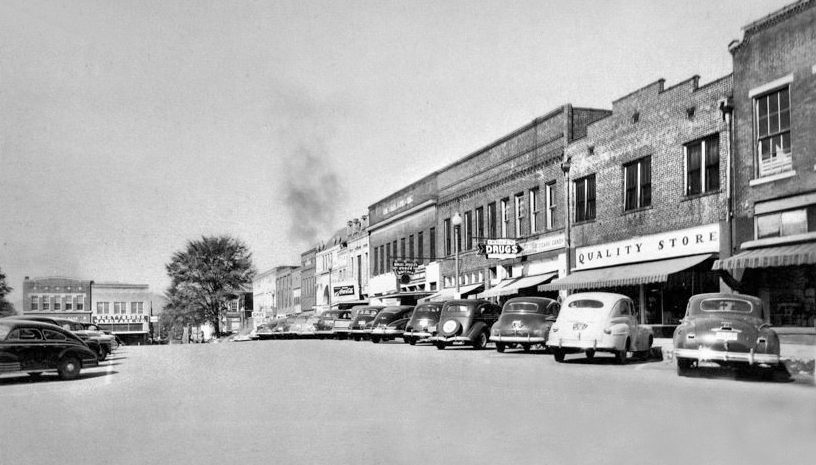
The Quality Store was owned by two gentlemen from Cullman named Zimmerman and Heinemann. It was managed by Albert Parks and his wife and Eva Marie Kennamer Parks. The Parks family’s initial association with the Quality Store came through Eva. She was a newlywed in her early 20s when Albert was drafted into service for World War II. She worked at the Quality Store throughout the war, and was manager of the store when Albert returned. Soon after Albert’s return, she was pregnant and no longer able to work, and Albert took her place at the Quality Store. Eva’s brother McDonald “Mack” Kennamer worked for the Adams family who owned the Darwin and Adams clothing store across the street.
When the two original owners of the Quality Store died, their heirs continued to operate the store for a time but eventually sold it. About this time, Albert Parks decided to open his own clothing store at the location that became known as Parks . A man named Ratliff from Birmingham bought the Scottsboro Quality Store and the entire Quality Store chain and called it Ratliff’s Quality Store. Here is a photo from the Jackson County Advertiser in November 1968 showing this name.
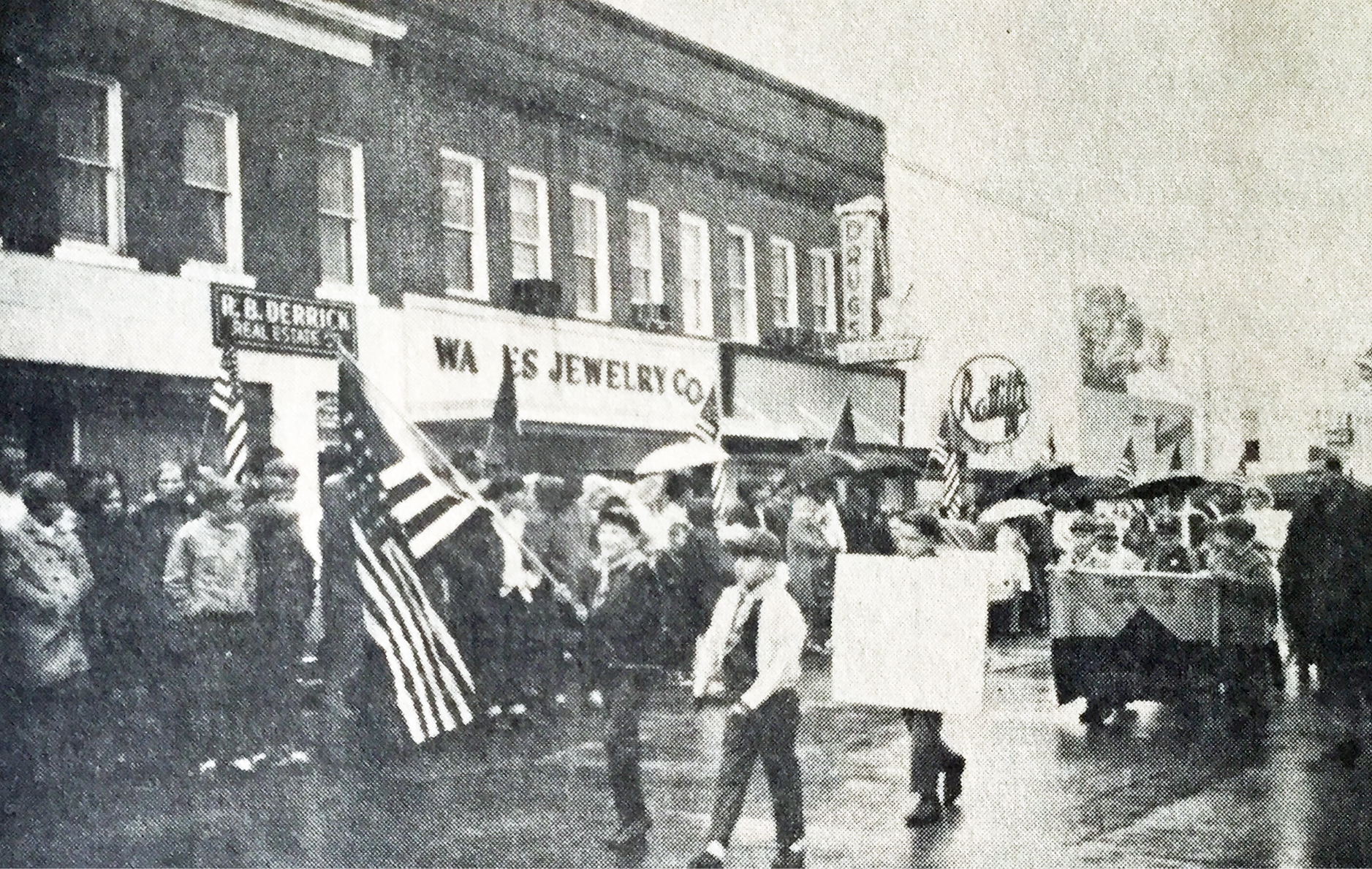
During the current renovation of this building, someone taped this wonderful photo of the 1940s Quality Store staff to the front of this building.
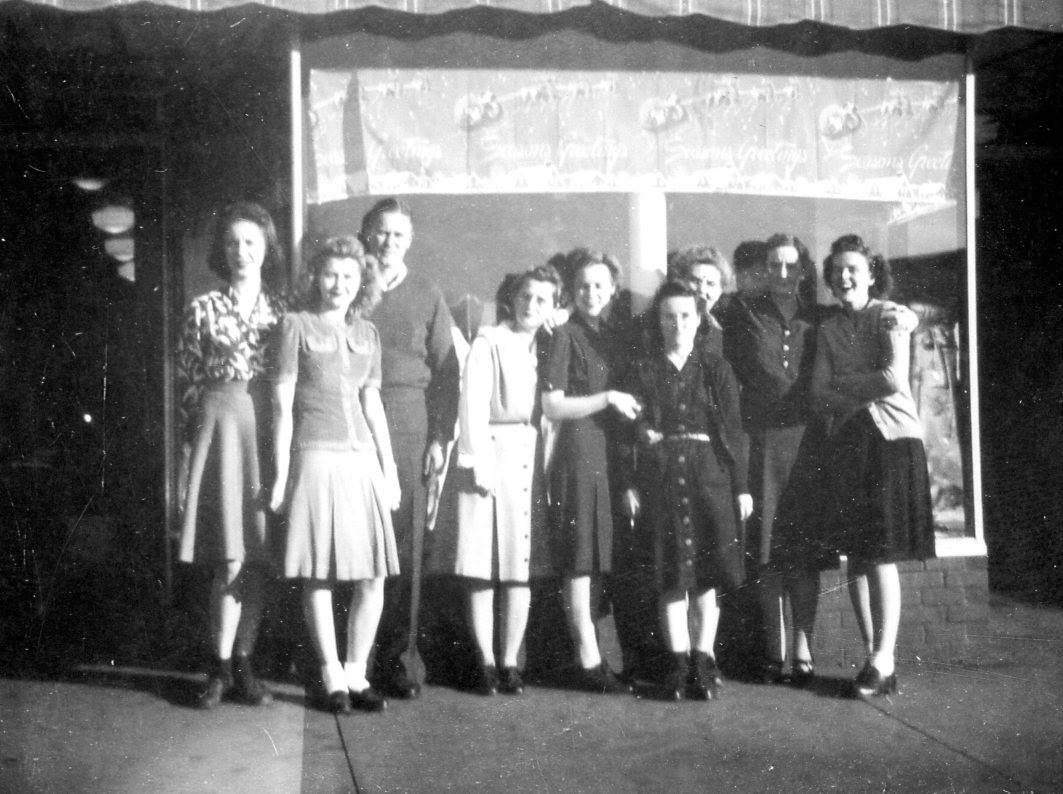
L to R, Mary E. McClendon, Ernestine Carver Bailey, Claude McGriff, Maude Boggus, Eva Mae Parks, Reba Tatum, Gertrude Brown, Belle Wilhelm, and Inez Law Starnes.
1949: Quality Store from the JCHS yearbook
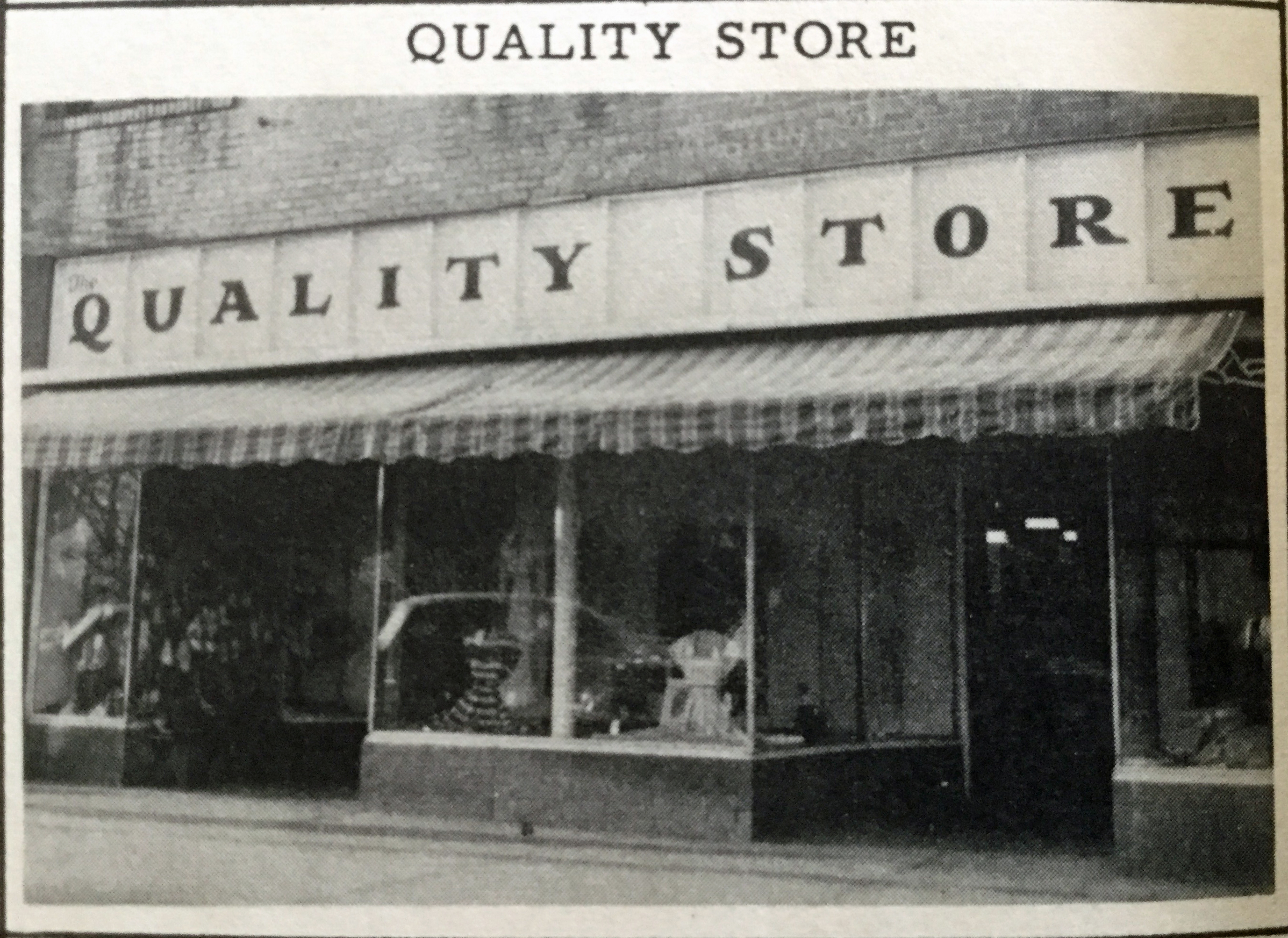
A 1952 Ad from The Progressive Age
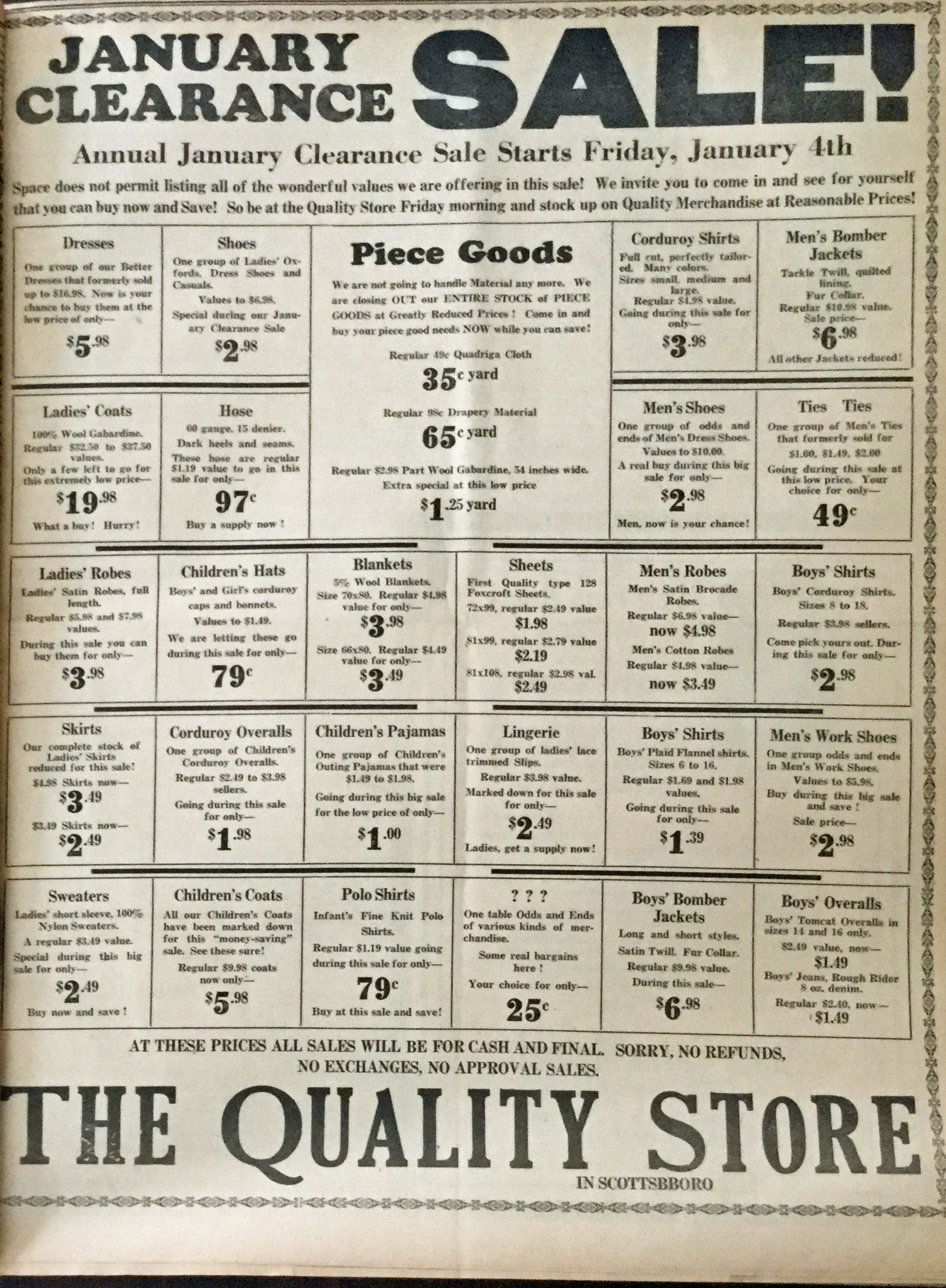
1970s: Remodeled as a paint store
After this location closed as some version of the Quality Store, Coy Barron redid the facade of the store to eliminate the stair-step top and opened a paint store, though as the photo below shows, that facade is still evident on the back of the building. In 1975, this build was home to Bargain Quality Outlet, as shown below. Most recently, it was a nail salon.
1975: Bargain Outlet Store
When the TVA did a photo survey of the town in preparation for the current renovations, Bargain Town Owlet was found in in this location.

2016: Old Quality Store stairstep facade remains in the back
For other views of the Robinson-Brown Building, see North Side of the Square.
Tales of the Quality Store
When she was just 14 years old, Ann Chambless went to work in the Quality Store. She recalls that Eva Parks did alterations for mens’ pants but asked her more agile 14-year-old employee to measure the men’s inseams for her. Ann recalls how awkward this was for her and how embarrassed she was to perform this task. She also recalls that when men entered the store to buy clothes for women who were not their wives, she was asked to try on and model the clothes.
Regarding alterations at the Quality Store, Bill Parks recalls that when Freddy Armstrong was doing alterations at the store, getting down in the floor to mark pant lengths for hemming was difficult. She began asking men to step up on a table so that the pants she was marking were closer to eye level. They had to stop the practice, however, when one day, they came in to find an 80-year-old man teetering around on top of the table while Freddy pinned his pants for hemming.
Inez Law Starnes worked in the Quality Store on Saturdays when she was still in high school. She said, “Mrs. Brown was Dr. Lynch’s wife’s sister. She worked there. She and I and Ernestine Carver, she’s Bailey now, she and I worked on Saturdays when we were still in high school….And then i worked for Libery National